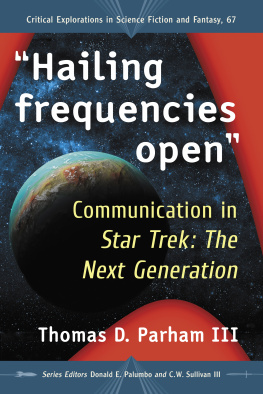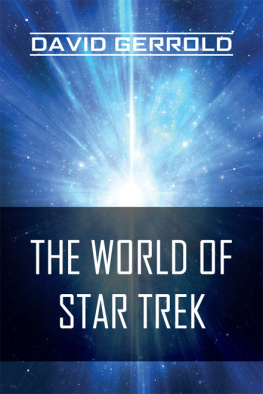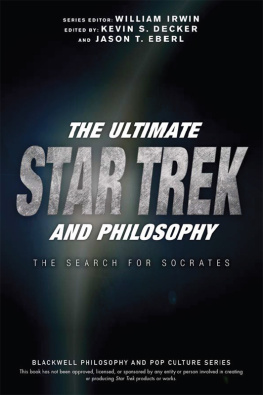1. Phasers Weapons of Less Destruction
1.1 Introduction
Space is a violent place. The temperature can range from almost 300 C (572 F) in the sunlight to 100 C (148 F) in the shade of the International Space Station. Space suits have both heaters and air conditioners to keep astronauts from freezing solid or boiling. In deep space it gets even colder, just 2.7 K above absolute zero (270.45 C/454.81 F). Exposure to the vacuum of space will cause bubbles to form in all the tissues of the body; the worst imaginable case of the bends. Lungs will collapse and any air in a body space will expand and explode. If this doesnt do the poor astronaut in immediately, the radiation of space will blind them, burn their skin and mutate their DNA in a thousand different ways. Space is not to be messed with.
It could be worse. Consider the possibility of roasting in a solar flare or being fenestrated by a fleck of cosmic dust traveling 27,576 kph (17,135 mph). Even worse, your home planet or space station might be obliterated by a passing asteroid or meteoroid. Outer space can be cruel to living things, and humans have only made the situation worse. Debris from past missions and satellites have come crashing to Earth. There is an entire program that tracks manmade space debris so that NASA or the ESA wont fly a spacecraft into a discarded wrench. Most disappointing, we have slowly begun to weaponize space. China used an antisatellite missile against one of their orbiting weather observers in 2007 and the US destroyed spy satellites with missiles in the 1980s and again in 2008. Russian cosmonauts still carry handguns on all missions, although discharging them is probably the worst thing they could do in a confined spaceship.
Have faith Star Trek shows us how space can become less violent over time. Even though weapons are prevalent in Star Trek , their usage goes down as the different series progress. When phasers first come to Star Trek in 2233 ( Star Trek 2009), they fire them every chance they get. Kirk and company of the original series speak of or use phaser weapons an average of 5.05 times per episode, but 24th century space explorers use them less often. Star Trek: The Next Generation series has 2.40 phaser mentions per episode, Deep Space Nine only 1.52, and Voyager has 2.12 phaser references in each hour long show.
Star Trek : Enterprise isnt included on the list because they dont have phasers, and they only make 1.12 references/show to phase pistols or phase rifles, the precursors to the phasers of the 23rd century ( TNG: A Matter of Time ). On the other hand, Enterprise uses their torpedoes more often than any other series (1.26 mentions/episode). Captain Archer doesnt have photon torpedoes at his disposal, only the Klingons have them before Kirk and Spock battle Nero in Star Trek (2009). Instead, the NX-01 Enterprise has spatial torpedoes ( ENT: Fight or Flight ) that are considerably less powerful than even the antimatter photonic torpedoes that immediately precede true photon torpedoes ( ENT: The Expanse ).
Photon torpedoes, and later quantum torpedoes, are used at a similar rate in the rest of the series (0.75/episode for TOS , 0.90 for TNG , 0.59 for DS9 and 1.03 for VOY ). One could argue that with less phaser usage and steady photon torpedo usage, the late 24th century universe is a safer place than the middle 2200s. Captain Janeway even makes mention of the wild days of Kirks time, Space must have seemed a whole lot bigger back thenthey were a little slower to invoke the Prime Directive, and a little quicker to pull their phasers. ( VOY: Flashback ) It would be wonderful if humans could avoid the Wild West days of space altogether, but at least we have a model for reducing violence in space over time. Everything we need to know about living together in space we can learn from Star Trek .
Box 1.1. A Note on Photon Torpedoes
The photon torpedo is a conventional kinetic weapon, it just has a more exotic delivery method and payload than traditional torpedoes. Kinetic weapons, either with or without high explosives, do damage via projectiles and shock waves. Even nuclear weapons are fairly conventional, the nuclear fission reaction is just a larger, more efficient way of producing shock waves and projectiles.
The payload made from mixing small amounts of matter and antimatter. The matter and antimatter are kept separate until the torpedoes arm themselves in mid-flight, and the impact of the torpedo against a target mix the deuterium and anti-deuterium. When they annihilate one another they produce an explosion and a lot of radiation ( VOY; Good Shepherd ).
24th century photon torpedoes have many small capsules of matter and antimatter that intermix at arming but remain segregated by magnetic separators. The separators degrade at impact and the reactant mix. They annihilate with a significantly higher yield because the matter and antimatter are more interspersed (Next Generation Technical Guide, p. 128). Notice that nowhere does light enter the reaction; the photon in the name is misleading.
Why theyre called torpedoes Aircraft fire missiles in air; ships fire torpedoes in water. Theres no water in space, so why are photon torpedoes so namedbecause spacecraft are more often referred to as ships (spaceships, starships) than planes. This might be because the term spaceship in literature predates the invention of the airplane. J.J. Astors 1894 novel, A Journey in Other Worlds , makes reference to a spaceship, while the Pall Mall Gazette (1880) uses the hyphenated word space-ship when referring to the projectile Jules Verne wrote of in From The Earth To The Moon (1865). These both predate the first airplane demonstration in 1906.
Space terminology borrows heavily from naval jargon; crew, bridge, course, admiral. The term torpedo once referred to what we would call mines, explosives set in place to be hit by unsuspecting vessels. This occurs in Star Trek as well, photon torpedoes are teletransported to designated locations in space and rigged to explode when struck ( VOY: Year of Hell , Dark Frontier ). One could conclude that torpedoes are fired into the ocean of space.
One indication that Star Trek crews were not eager to kill or do violence is that they could set phasers to stun, to do the least amount of damage necessary. Over the centuries, phaser weapons gain more precision to give the user more chances to avoid killing. The earliest type 1 (handheld) phasers have eight settings, ranging from stun to disrupt or vaporize (Star Trek: The Next Generation Technical Guide, p. 135). The 24th century type 2 and type 3 phasers have 16 settings; they arent damaging until level four, and one must use setting seven for them to be deadly (TNG Technical Guide, p. 136). Even photon torpedoes have power settings, from fireworks (level 1) to a level 10 that is so powerful that it violates strategic arms treaties (Sternbach and Okuda , p. 22).
Sublethal or nonlethal versions of weapons give the user a chance to contemplate his/her actionsjust how much force do they need to exercise? This already makes space in the Star Trek universe a safer place than Earth in the 21st century. No handgun or rifle built today can be dialed down from lethal to nonlethal. The challenge is clearcan humans follow Star Treks lead and choose to develop directed energy weapons for use on Earth and in space that can be nonlethal? Happily, the answer seems to be yes, though we have to keep in mind that nonlethal energy weapons can often become lethal at the flick of a switch. The amazing thing is just how researchers are harnessing energy in weapons; there are even ways to bend a lightning bolt inside a laser beam around a corner to get at an enemyeven Star Trek didnt think of that one.









